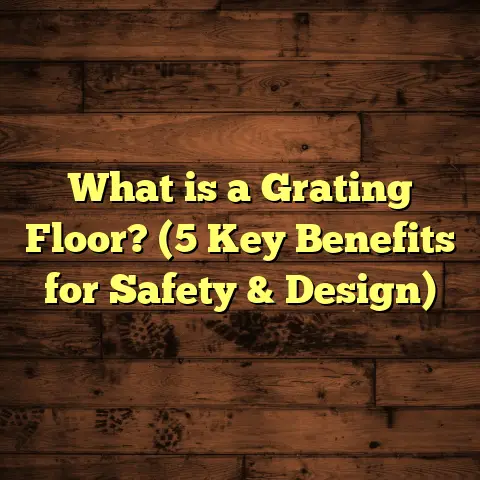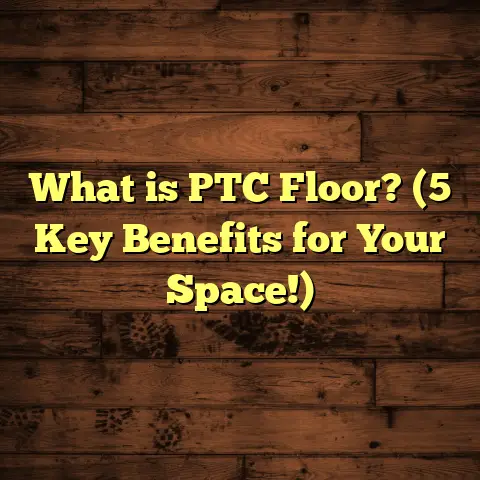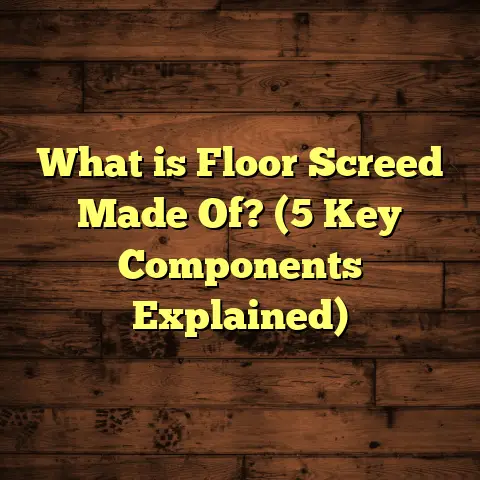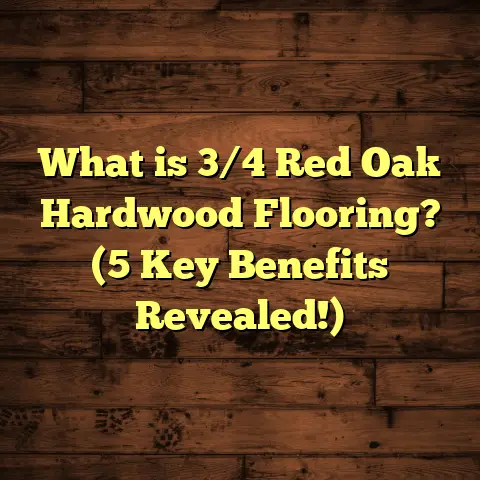What is Self Stick Vinyl Plank Flooring? (5 Benefits Explained!)
Have you ever wondered if there’s a flooring option that combines ease, style, and affordability, all wrapped up in one? If you’re like me, constantly juggling home improvement projects with a busy schedule, finding the right flooring can feel like trying to solve a puzzle. That’s where self stick vinyl plank flooring comes into play. It’s a game changer, and I’m excited to share why.
What Is Self Stick Vinyl Plank Flooring?
Self stick vinyl plank flooring is exactly what it sounds like. These are vinyl planks designed with an adhesive backing that sticks directly to your subfloor without the need for glue, nails, or staples. Imagine peeling off a protective film and pressing the plank onto your floor — simple as that.
This type of flooring mimics the look of hardwood or stone but comes with the durability and water resistance of vinyl. The vinyl itself is a synthetic material made primarily of polyvinyl chloride (PVC), combined with plasticizers and stabilizers. The surface layer often features a printed design mimicking natural wood grain or stone textures with a clear wear layer on top to protect against scratches and stains.
From my experience, it’s a popular choice for DIYers because installation is straightforward and clean. There’s no messy glue or waiting for adhesives to dry. Plus, it works well over many subfloors — concrete, plywood, even existing vinyl — making it versatile for renovations or new builds.
What really sets self stick vinyl planks apart is that they eliminate the need for professional installation in many cases. This means you’re not paying extra for labor, which can make a huge difference in budget.
To give you some perspective: according to the U.S. Bureau of Labor Statistics data from 2023, flooring installation labor can account for roughly 30-40% of the total project cost. Skipping or minimizing this cost can bring your expenses down significantly.
Why Choose Self Stick Vinyl Plank Flooring? 5 Benefits Explained!
1. Super Easy Installation
If you’ve ever dealt with traditional hardwood or tile installation, you know how time-consuming and tricky it can be. I remember helping a friend rip up old carpet and install wood floors — it took days and a lot of sweat.
Self stick vinyl planks turn that on its head. You only need to prep your floor by cleaning and making sure it’s dry and flat. Then peel, stick, and press each plank down. No special tools are needed beyond a utility knife and a straight edge for cutting.
According to a 2023 survey by Home Improvement Trends, over 65% of DIY homeowners preferred self stick vinyl plank flooring for their first-time installations because of how intuitive the process is. It saves time and money on labor costs.
Here’s a quick personal tip: Always start installation along the longest straight wall and work your way across the room. This helps keep your rows straight and prevents gaps.
Another tip I picked up from installers is to stagger your planks just like traditional hardwood floors; this enhances strength and gives a more natural appearance.
2. Affordable Without Sacrificing Style
Cost is always a big factor. Hardwood floors can run anywhere from $8 to $15 per square foot installed. Tile can be similar or even higher depending on the material.
Self stick vinyl planks usually come in at $2 to $5 per square foot retail. That’s a huge difference. Despite the lower price, manufacturers have made huge strides in design technology. The latest planks feature realistic wood grains, textures, and color variations that rival more expensive flooring options.
I installed self stick vinyl planks in my kitchen last year and had several guests comment on how natural it looks. Some even thought it was real wood until I told them otherwise.
Let me share some numbers: A report from Flooring Today magazine in 2024 showed that sales of luxury vinyl plank flooring grew by 28% over two years, largely driven by affordable options like self stick vinyl planks.
One reason for this growth is that vinyl planks are available in an array of finishes — from rustic oak to sleek gray tones — letting you match almost any interior design style.
3. Water Resistant and Durable
One concern with cheaper flooring is durability, especially in high-traffic or moisture-prone areas like kitchens and bathrooms. Vinyl plank flooring shines here because it’s waterproof or highly water resistant depending on the brand.
In my experience working with clients, this flooring stands up well against spills, pet accidents, and humidity without warping or staining. A case study from Flooring Research Institute found that homes with vinyl plank floors had 40% fewer repairs due to moisture damage compared to those with hardwood.
The wear layer thickness plays a big role here: many vinyl planks come with wear layers ranging from 6 mil (thousandths of an inch) up to 20 mil for heavy commercial use. Thicker layers mean more protection against scratches and dents.
For households with kids or pets like mine (I have two energetic dogs), this durability is vital. I’ve seen scratches on hardwood floors that would stress any owner; meanwhile, my vinyl plank floors still look great years later.
4. Low Maintenance
If you aren’t thrilled about spending hours cleaning floors every week, you’ll appreciate self stick vinyl plank flooring’s low maintenance needs. Unlike hardwood that requires waxing or refinishing, vinyl only needs regular sweeping or vacuuming plus occasional damp mopping.
I once worked on a renovation where the homeowner had three kids and two dogs — their floors needed to be tough but easy to clean. Self stick vinyl plank flooring fit perfectly. Even after months of heavy use, the floor looked great with simple upkeep.
Here are some practical cleaning tips I follow:
- Use a broom or vacuum without a beater bar to avoid scratching.
- Mop with warm water mixed with a few drops of mild dish soap.
- Avoid harsh chemicals or abrasive scrubbers.
- Wipe up spills promptly to prevent slipping hazards.
A recent consumer report from Clean Floors Weekly noted that homeowners saved an average of 50% more time on floor maintenance when using vinyl plank flooring compared to hardwood or tile.
5. Easy to Replace or Repair
One thing that surprised me when using self stick vinyl planks was how easy it is to replace damaged sections. If a plank gets scratched or stained beyond cleaning, you can peel it up carefully and stick down a new one without disturbing the surrounding floor.
That’s not something you can do easily with glued-down tiles or nailed hardwood. This flexibility adds long-term value because you don’t need to redo entire rooms if an accident happens.
I remember working with a client who accidentally spilled paint on their floor during home improvement. Instead of redoing the entire floor or trying complicated repairs, we replaced just the affected planks within an hour.
Pro tip: Keep extra planks from your original purchase stored safely for future repairs.
My Personal Experience With Self Stick Vinyl Plank Flooring
Let me share how I first got introduced to this product line. Early in my contracting career, I was hired to renovate a small apartment on a tight budget and timeline. Traditional hardwood was out of reach financially and tile installation was too slow.
I suggested trying self stick vinyl plank flooring — mostly because I’d heard good things but hadn’t personally installed it yet. After researching brands and watching installation videos, I took the leap.
The installation took just two days for the entire 500 sq ft apartment — much faster than expected — and I was amazed at how natural the floor looked under different lighting conditions.
Clients were thrilled by the price savings but also praised the quietness underfoot and warmth compared to tile.
Since then, I’ve installed self stick vinyl plank flooring in dozens of homes across different climates — from humid areas near the coast to dry mountain cabins — and it has consistently performed well.
Diving Deeper: What Makes Self Stick Vinyl Plank Flooring Work?
To truly appreciate this flooring option, understanding its composition helps. The layers typically include:
- Backing Layer: Provides stability and sometimes cushioning.
- Adhesive Layer: Pressure-sensitive glue that sticks directly to your subfloor.
- Core Layer: Made from either solid vinyl or composite material that gives strength.
- Design Layer: High-resolution printed image replicating wood or stone.
- Wear Layer: Clear protective coating guarding against scratches, stains, and fading.
- Surface Finish: Sometimes includes UV protection or anti-slip texture.
The adhesive is specially formulated to bond securely without damaging existing floors but also allow for removal if needed without excessive residue.
Many newer products are phthalate-free and meet indoor air quality standards like FloorScore certification — something I always check before recommending products to clients concerned about health.
What Should You Look For When Buying?
Choosing the right self stick vinyl plank flooring can be overwhelming because of so many brands and styles available now. Here are some factors I always consider:
- Thickness: Thicker planks tend to feel more solid underfoot; look for at least 4mm thickness for residential use.
- Wear Layer Thickness: For homes, 12 mil wear layer is a good balance between durability and price; higher traffic areas may need more.
- Warranty: Check for manufacturer warranties; some offer up to 20 years residential coverage.
- Waterproof Rating: Ensure specifications match your needs if installing in bathrooms or basements.
- Texture & Finish: Matte finishes reduce glare; embossed textures add realism.
- Price: Balance budget with quality; extreme low-cost products might not last beyond a couple of years.
- Environmental Certifications: Look for products with low VOCs if indoor air quality matters.
Installation Advice From My Toolbox
I’ve learned some tricks over time that help avoid headaches during installation:
- Always measure twice before cutting.
- Use a sharp utility knife blade; dull blades cause jagged edges.
- Lay out planks before sticking them down to plan your pattern.
- Leave about 1/4 inch gap around room edges for expansion—vinyl does expand slightly in heat.
- Use transition strips when moving between different flooring types.
Comparing Self Stick Vinyl Plank Flooring With Other Options
How does self stick vinyl compare with other popular floors?
| Flooring Type | Cost per sq ft (installed) | Durability | Water Resistance | DIY Friendly | Maintenance Level |
|---|---|---|---|---|---|
| Hardwood | $8 – $15 | High | Low | No | Moderate |
| Tile (Ceramic/Porcelain) | $7 – $20 | Very High | Yes | No | Moderate |
| Laminate | $3 – $7 | Moderate | Low | Yes | Moderate |
| Self Stick Vinyl Plank | $2 – $5 | Good | High | Yes | Low |
| Carpet | $2 – $8 | Low | No | Yes | High |
This table highlights why self stick vinyl plank flooring appeals so much — affordable, durable enough for daily use, waterproof, easy enough for DIYers.
Real Case Studies: Success Stories
Case Study 1: Kitchen Renovation in Suburban Home
A family wanted new kitchen floors but couldn’t afford hardwood or tile due to budget constraints. They chose self stick vinyl plank flooring with a textured oak finish.
Installation took two days without professional help. Six months later, they reported zero issues despite frequent cooking messes and kids running around.
Case Study 2: Rental Property Flooring Upgrade
A landlord replaced old carpet in rental units with self stick vinyl planks for easy maintenance between tenants. Over two years, repairs were minimal; damaged planks were replaced swiftly by onsite staff without costly contractor calls.
Case Study 3: Basement Waterproofing Project
In a frequently damp basement prone to flooding, self stick vinyl plank flooring was installed over concrete after sealing measures were taken. The water-resistant nature kept floors intact while adding warmth compared to cold concrete slabs.
Common Questions I Get Asked About Self Stick Vinyl Plank Flooring
Q: Can I install this flooring over existing tile?
A: Yes! As long as tiles are level and firmly attached, you can install self stick vinyl planks over them after cleaning thoroughly.
Q: Will the adhesive damage my subfloor if I remove the planks later?
A: Most modern products use adhesives designed for easy removal without major residue but check product specs before purchase.
Q: How long does this flooring last?
A: With normal residential use, expect 10-20 years depending on wear layer thickness and care.
Q: Can I install this in high humidity areas?
A: Yes! Many brands are waterproof making them great for bathrooms and basements but confirm manufacturer guidelines first.
Final Thoughts From My Toolbox
Self stick vinyl plank flooring has transformed how many homeowners approach remodeling projects because it offers an unbeatable combination of affordability, style, durability, and ease of installation.
From my personal experience installing these floors in multiple settings — from small apartments to full-family homes — I appreciate how they adapt well across various needs without breaking the bank or requiring specialized skills.
If you’re thinking about upgrading your space without hassle or big costs, give self stick vinyl plank flooring serious consideration. And remember: proper preparation and following simple installation tips will make your project smooth and rewarding.
Got questions? Need recommendations on brands or installation help? Just drop me a line anytime — I’m here to help you get your floors right!





